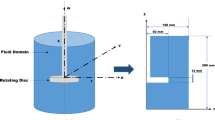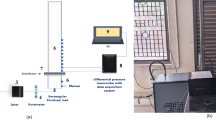Abstract
Gas turbine engines for fixed-wing or rotary-wing aircraft are operated in a variety of harsh weather environments ranging from arctic, volcanic zones, to desert conditions. Operation under these degraded conditions leads to the undesired entrainment of complex particulates resulting in drastic performance losses. Hence, there is a critical need to understand the governing mechanisms to inform the development of durable thermal and environmental barrier coatings. The objective of the current work is to present a novel multiscale physics-based approach to study two-phase flows that take into account the underpinning particle transport and deposition dynamics. Sessile droplet models are presented and used to compute the contact angle at high temperatures and compared with experiments. The study also investigates the sensitivity of deposition patterns to the Stokes number and the results identify local vulnerability regions. The analysis suggests that particle size distributions and the initial trajectories of the particles are critically important in predicting the final deposition pattern.










Similar content being viewed by others
References
A. Filippone and N. Bojdo: Turboshaft engine air particle separation. Prog. Aerosp. Sci. 46, 224–245 (2010).
A. Van Dokelarr, R.V. Martin, M. Brauer, R. Kahn, R. Levy, C. Verduzco, and P.J. Villeneuve: Global estimates of ambient fine particulate matter concentrations from satellite-based aerosol optical depth: Development and application. Environ. Health Perspect. 118, 847–855 (2010).
M. Walock, B. Barnett, A. Ghoshal, M. Murugan, J.J. Swab, M.S. Pepi, D. Hopkins, G. Gazonas, C. Rowe, and K. Kerner: Micro-scale sand particles within the hot section of a gas turbine engine. In Mechanical Properties and Performance of Engineering Ceramics and Composites XI: Ceramic Engineering and Science Proceedings, Salem J, Singh D, Fukushima M and Gyekenyesi A, eds, Vol, 37. (John Wiley & Sons, Hoboken, New Jersey, 2017), pp. 159–170.
A. Nieto, M. Walock, A. Ghoshal, D. Zhu, W. Gamble, B. Barnett, M. Murugan, C. Pepi, C. Rowe, and R. Pegg: Layered, composite, and doped thermal barrier coatings exposed to sand laden flows within a gas turbine engine: Microstructural evolution, mechanical properties, and CMAS deposition. Surf. Coat. Technol. 349, 1107–1116 (2018).
A. Ghoshal, M. Murugan, M.J. Walock, A. Nieto, B.D. Barnett, M.S. Pepi, J.J. Swab, D. Zhu, K.A. Kerner, C.R. Rowe, C.Y. Shiao, D.A. Hopkins, and G.A. Gazonas: Molten particulate impact on tailored thermal barrier coatings for gas turbine engine. J. Eng. Gas Turbines Power 140, 022601 (2018).
M. Murugan, A. Ghoshal, M.J. Walock, B.D. Barnett, M.S. Pepi, and K.A. Kerner: Sand particle-Induced deterioration of thermal barrier coatings on gas turbine blades. Adv. Aircr. Spacecr. Sci. 4, 37 (2017).
D.K. Larry Fehrenbacher, J. Kutsch, I. Vesnovsky, E. Fehrenbacher, A. Ghoshal, M. Walock, M. Murugan, and A. Nieto: Advanced environmental barrier coatings for SiC CMCs. In Advances in Ceramics for Environmental, Functional, Structural, and Energy Applications II, Vol. 266, M.M. Mahmoud, K. Sridharan, H. Colorado, A.S. Bhalla, J.P. Singh, S. Gupta, J. Langhorn, A. Jitianu and N. Jose Manjooran, eds. (John Wiley & Sons, Hoboken, NJ, USA, 2019), pp. 83–93.
S. Balachandar and J.K. Eaton: Turbulent dispersed multiphase flow. Annu. Rev. Fluid Mech. 42, 111–133 (2010).
A. Guha: Transport and deposition of particles in turbulent and laminar flow. Annu. Rev. Fluid Mech. 40, 311–341 (2008).
S. Elghobashi: An updated classification map of particle-laden turbulent flows. In IUTAM Symposium on Computational Approaches to Multiphase Flow, Proceedings of an IUTAM Symposium held at Argonne National Laboratory, 4–7 October 2007.
E. Loth: Numerical approaches for motion of dispersed particles, droplets, and bubbles. Prog. Energy Combust. Sci. 26, 161–223 (2000).
R.O. Fox: Large-eddy-simulation tools for multiphase flows. Annu. Rev. Fluid Mech. 44, 47–76 (2012).
A. Passalacqua, F. Laurent, E. Madadi-Kandjani, J.C. Heylmun, and R. Fox: An open-source quadrature-based population balance solver for OpenFOAM. Chem. Eng. Sci. 176, 306–318 (2018).
M. Uhlmann: Interface-resolved direct numerical simulation of vertical particulate channel flow in the turbulent regime. Phys. Fluids 20, 053305 (2008).
R. Fox, F. Laurent, and F. Massot: Numerical simulation of spray coalescence in an Eulerian framework: Direct quadrature method of moments and multi-fluid method. J Comput. Phys. 277, 3058–3088 (2008).
S. Elghobashi: Direct numerical simulation of turbulent flows laden with droplets or bubbles. Annu. Rev. Fluid Mech. 51, 217–244 (2019).
Y. Kozak, S.S. Dammati, L.G. Bravo, P.E. Hamlington, and A.Y. Poludnenko: WENO interpolation for Lagrangian particles in highly compressible flow regimes. J. Comput. Phys. 402, 109054 (2020).
T.Y. Ma, F. Zhang, H.F. Liu, and M.F. Yao: Modeling of droplet/wall interaction based on SPH method. Int. J. Heat Mass Transfer 105, 296–304 (2017).
X. Yang, L. Dai, and S.-C. Kong: Simulation of liquid drop impact on dry and wet surfaces using SPH method. Proc. Combust. Inst. 36, 2393–99 (2017).
J.H. Snoeijer and B. Andreotti: Moving contact lines: Scales, regimes, and dynamical transitions. Annu. Rev. Fluid Mech. 35, 269–292 (2013).
L. Bravo, Q. Xue, M. Murugan, A. Ghoshal, M. Walock, and A. Flatau: Particle transport analysis of sand ingestion in gas turbine jet engines. In 53rd AIAA/SAE/ASEE Joint Propulsion Conference of the American Institute of Aeronautics and Astronautics, Atlanta, GA, 2017.
D.I. Graham and P.W. James: Turbulent dispersion of particles using eddy interaction models. Int. J. Multiphase Flow 22, 157–175 (1999).
A. Mofakham and G. Ahmadi: Particle dispersion and deposition in inhomogeneous turbulent flows using continuous random walk models. Phys. Fluids 31, 083301 (2019).
J.P. Bons, R. Prenter, and S. Whitaker: A simple physics based model for particle rebound and deposition in turbomachinery. J. Turbomach. 139, 081009 (2017).
S. Singh and D. Tafti: Particle deposition model for particulate flows at high temperatures in gas turbine engine components. Int. J. Heat Fluid Flow 52, 72–83 (2015).
N. Bojdo and A. Filippone: A simple model to assess the role of dust composition and size on deposition in rotorcraft engines. Aerospace 6, 44 (2019).
C. Huh and L.E. Scriven: Hydrodynamic model of steady movement of a solid/liquid/fluid contact line. J. Colloid Interface Sci. 35, 85–101 (1971).
Z. Du, J. Wang, S. Wen, P. Wang, D. Zhang, and C. Yin: Study on the properties of UHMW-PE film. Adv. Mater. Phys. Chem. 5, 337–343 (2015).
Y.X. Kang, Y. Bai, G.Q. Du, F.L. Yu, C.G. Bao, Y.T. Wang, and F. Ding: High temperature wettability between CMAS/YSZ coating with tailored surface microstructures. Mater. Lett. 229, 40–43 (2018).
T. Arts and M.L. De Rouvroit: Aero-thermal performance of a two-dimensional highly loaded transonic turbine nozzle guide vane: A test case for inviscid and viscous flow computations. J. Turbomach 114, 147–154 (1992).
M. Ray, X. Yang, S.-C. Kong, L. Bravo, and C-B.M. Kweon: High-fidelity simulation of drop collision and vapor–liquid equilibrium of van der Waals fluids. Proc. Combust. Inst. 36, 2385–2392 (2017).
X. Yang and S.-C. Kong: Smoothed particle hydrodynamics method for evaporating multiphase flows. Phys. Rev. E 96, 033309 (2017).
G.A. Brès, S.T. Bose, M. Emory, F.E. Ham, O.T. Schmidt, G. Rigas, and T. Colonius: Large-Eddy simulations of co-annular turbulent jet using a Voronoi-based mesh generation framework. In AIAA/CEAS Aeroacoustics Conference (American Institute of Aeronautics and Astronautics, Atlanta, GA, USA, 2018).
F. Ham, S. Bose, B. Hejazi, and V. Mittal: A low-dissipation numerical scheme on Voronoi grids for complex geometries. In 68th Annual Meeting of the APS Division of Fluid Dynamics, Vol. 60 (American Physical Society, Boston, MA, USA, 2015).
B.H. Joo, G. Medic, D.A. Philips, and S.T. Bose: Large-eddy simulation of a compressor rotor. In Proceedings of the Stanford Summer Program, Center for Turbulence Research, Stanford, CA, 2014; p. 467.
N. Jain, L. Bravo, D. Kim, M. Murugan, A. Ghoshal, F. Ham, and A. Flatau: Massively parallel large eddy simulation of rotating turbomachinery for variable speed gas turbine engine operation. Energies 13, 703 (2020).
W. Vreman A: An eddy-viscosity subgrid-scale model for turbulent shear flow: Algebraic theory and applications. Phys. Fluids 16, 367081 (2004).
C. Crowe, M. Sommerfeld, and Y. Tsuju: Multiphase Flows with Droplets and Particles (CRC Press, Boca Ranton, FL, 1998).
L. Bravo, D. Kim, F. Ham, and K. Kerner: High fidelity simulation of primary breakup and vaporization of liquid jet in cross flow. In AIAA-2018-4683, 2018 Joint Propulsion Conference, Cincinatti, OH, 2018.
Q. Du, V. Faber, and M. Gunzburger: Centroidal Voronoi tessellations: Applications and algorithms. SIAM Rev. 41, 637–676 (1999).
Acknowledgments
This work was supported in part by resources from the DoD High-Performance Computing Modernization Program (HPCMP) FRONTIER Award to ARL with project title “Petascale High Fidelity Simulation of Atomization and Spray/Wall Interactions”. L.B., A.G., and M.M. were supported by the VTD 6.1 basic research mission program in propulsion sciences and a DoD Laboratory University Collaborative Initiative (LUCI) Fellowship. The simulations were run on the Centennial HPC System at the ARL DSRC. This work was conceptualized through ARL participation in the 2018 Center for Turbulence Research Summer Program at Stanford University.
Author information
Authors and Affiliations
Corresponding author
Rights and permissions
About this article
Cite this article
Bravo, L.G., Jain, N., Khare, P. et al. Physical aspects of CMAS particle dynamics and deposition in turboshaft engines. Journal of Materials Research 35, 2249–2259 (2020). https://doi.org/10.1557/jmr.2020.234
Received:
Accepted:
Published:
Issue Date:
DOI: https://doi.org/10.1557/jmr.2020.234




